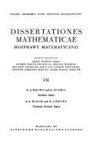赋范半群上的熵(走向熵的统一方法)
IF 0.8
3区 数学
Q1 MATHEMATICS
引用次数: 15
摘要
我们提出了一种统一的方法来研究数学中的熵,如度量熵、拓扑熵、代数熵、集合熵。我们考虑离散动力系统,即对$(X,T)$,其中$X$是底层空间,$T:X\to X$是变换。我们将熵视为函数$h:\mathfrak X\to \mathbb R_+$,与类别$\mathfrak X$的每个流$(X,T)$相关联,要么是非负实数,要么$\infty$。引入半群熵$h_\mathfrak S:\mathfrak S\to\mathbb R_+$的概念,它是赋范半群的$\mathfrak S$范畴自同态的一个数值不变量。然后,对于从任意特定类别$\mathfrak X$到$\mathfrak S$的函子$F:\mathfrak X\to\mathfrak S$,我们将函子熵$h_F:\mathfrak X\to\mathbb R_+$定义为复合$h_{\mathfrak S}\circ F$。显然,$h_F$继承了$h_\mathfrak S$的许多属性,这也取决于$F$的属性。这种一般方案允许获得相关的已知熵如函子熵$h_F$,对于适当的类别$\mathfrak X$和函子$F$,并建立它们共有的性质。这样我们就指出了它们的共同性质。最后,我们通过我们统一方法的“镜子”来讨论和深入分析熵对之间的关系。为此,我们形式化了两个熵之间的桥定理的概念$h_i:\mathfrak X_i\to \mathbb R_+$, $i=1,2$,关于函子$\varepsilon:\mathfrak X_1\to\mathfrak X_2$。然后,对于函数熵对,我们使用上述格式引入了强桥定理的概念和相关格式,使我们能够将熵对之间的各种关系放在同一保护伞下。本文章由计算机程序翻译,如有差异,请以英文原文为准。
Entropy on normed semigroups (towards a unifying approach to entropy)
We present a unifying approach to the study of entropies in Mathematics, such as measure entropy, topological entropy, algebraic entropy, set-theoretic entropy. We take into account discrete dynamical systems, that is, pairs $(X,T)$, where $X$ is the underlying space and $T:X\to X$ a transformation. We see entropies as functions $h:\mathfrak X\to \mathbb R_+$, associating to each flow $(X,T)$ of a category $\mathfrak X$ either a non negative real or $\infty$. We introduce the notion of semigroup entropy $h_\mathfrak S:\mathfrak S\to\mathbb R_+$, which is a numerical invariant attached to endomorphisms of the category $\mathfrak S$ of normed semigroups. Then, for a functor $F:\mathfrak X\to\mathfrak S$ from any specific category $\mathfrak X$ to $\mathfrak S$, we define the functorial entropy $h_F:\mathfrak X\to\mathbb R_+$ as the composition $h_{\mathfrak S}\circ F$. Clearly, $h_F$ inherits many of the properties of $h_\mathfrak S$, depending also on the properties of $F$. Such general scheme permits to obtain relevant known entropies as functorial entropies $h_F$, for appropriate categories $\mathfrak X$ and functors $F$, and to establish the properties shared by them. In this way we point out their common nature. Finally, we discuss and deeply analyze through the looking glass of our unifying approach the relations between pairs of entropies. To this end we formalize the notion of Bridge Theorem between two entropies $h_i:\mathfrak X_i\to \mathbb R_+$, $i=1,2$, with respect to a functor $\varepsilon:\mathfrak X_1\to\mathfrak X_2$. Then, for pairs of functorial entropies we use the above scheme to introduce the notion and the related scheme of Strong Bridge Theorem, which allows us to put under the same umbrella various relations between pairs of entropies.
求助全文
通过发布文献求助,成功后即可免费获取论文全文。
去求助
来源期刊
CiteScore
2.80
自引率
0.00%
发文量
8
审稿时长
>12 weeks
期刊介绍:
DISSERTATIONES MATHEMATICAE publishes long research papers (preferably 50-100 pages) in any area of mathematics. An important feature of papers accepted for publication should be their utility for a broad readership of specialists in the domain. In particular, the papers should be to some reasonable extent self-contained. The paper version is considered as primary.
The following criteria are taken into account in the reviewing procedure: correctness, mathematical level, mathematical novelty, utility for a broad readership of specialists in the domain, language and editorial aspects. The Editors have adopted appropriate procedures to avoid ghostwriting and guest authorship.

 求助内容:
求助内容: 应助结果提醒方式:
应助结果提醒方式:


